HEPA models, like this one from Delta, are capable of lifting extremely fine particles and are well-suited for lead abatement jobs. (Photo: Courtesy of Allen Cheuvront)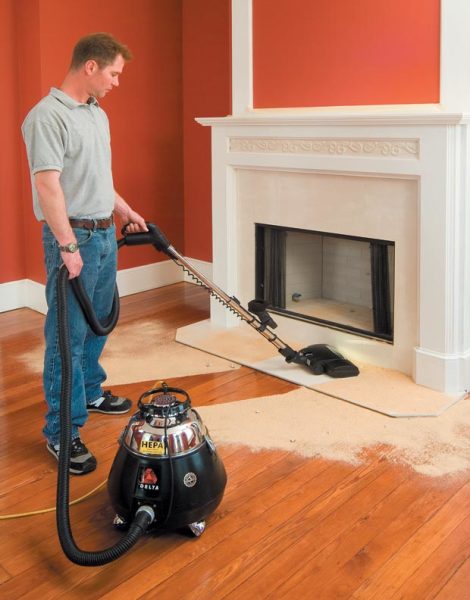
The wet-dry vacuum is our barrel-shaped friend—a personal, practical R2-D2 from Star Wars, rolling along behind us as we clean up after repairs. Whether it’s picking up paint chips and sawdust or absorbing a springtime basement flood, old-house owners can’t imagine living without it.
Industrial- or commercial-grade vacuums come in various sizes with many features, but with prices ranging between $79 and $1,000, how do you pick from the many models and brands available to find the right one for you? Which features will facilitate the jobs you’re doing, and which components will make your project site safer? You don’t have to be a professional to consider investing in a quality vacuum that will last as long as your old house has projects for you to work on.
Wet, Dry, or Both?
First, consider what you’ll be vacuuming. I count on my utility vacuum to come to the rescue when my clothes washer overflows as much as I do for cleaning up after plaster repairs. That’s not the case for everyone. Many utility vacs are made only for dry use and come in compact sizes and light weights—a great option for homeowners who never need to work with water.
If, however, you want your vacuum to double as a basement sump pump every spring, you need something with a large capacity. A five-gallon tank, for instance, fills up in seconds, whereas a 20-gallon tank sucks up more water. That unit, of course, is also bulkier, heavier to lug up stairs, and trickier to store. Vacuums on wheels are easier to move around when heavy with water and should have a drain convenient for easy emptying. Be sure it has a check valve or electronic shut- off to protect the motor from water splash and overflow.
Airflow and Water Lift
Well-placed handles and wheels are ergonomic innovations that make transporting vacuums up stairs and around obstacles less onerous. (Photo: Courtesy of Ridgid Tool Co.)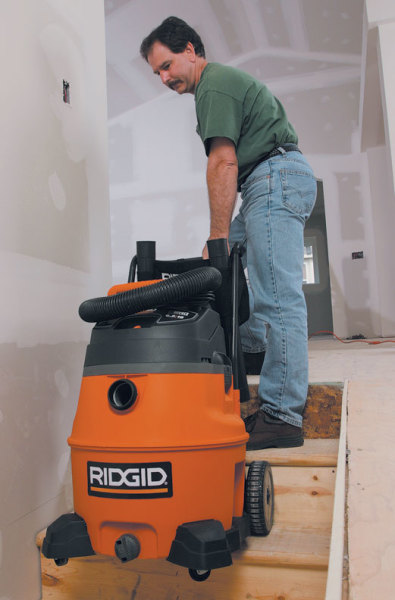
Vacuum strength is rated in two ways: Airflow and water lift. A vacuum’s airflow—the speed at which it pulls in air through an unobstructed hose—is measured as CFM (cubic feet per minute). Water lift refers to the machine’s suction capacity as determined by a manometer, a device that calculates both pressure and suction strength.
Vacuuming takes a combination of airflow and water lift: Part of the hose opening is unrestricted, allowing air to flow and pull into the vacuum, and part of the opening is under pressure, sucking and lifting debris. Strong airflow allows the vacuum to pull fine dust from many inches away, and high water lift enables the machine to grab particles out of cracks and inhale large pieces easily. Look for vacuums with an airflow CFM rating of over 112 and a water lift of at least 80.
Filtration
There’s a lot more to filtration than meets the eye, and it should be high on your list of preferred vacuum features because of the potential hazards of some old-house repairs. The dust we can’t see is the most dangerous, and if you own a house built before 1978, you should assume it contains lead paint. When working around lead paint debris, HEPA (high-efficiency particulate air) filters—with many thick, dense layers to trap tiny particles—are essential, as is a well-sealed unit. Vacuums for lead abatement must be rated for fine filtration with a 99.97-percent efficiency for particles of 0.3 micron.
For non-HEPA vacuums, filter shape, size, style, and configuration all contribute to a vacuum’s effectiveness. The best vacuums have multiple stages of filtration, stopping large particles with their outermost layer while passing minute particles through several filters before capturing them in a finer, more expensive cartridge or filter.
With wet vacs, some filtration often must be removed for the machine to suck up water. (Photo: Courtesy of Ridgid Tool Co.)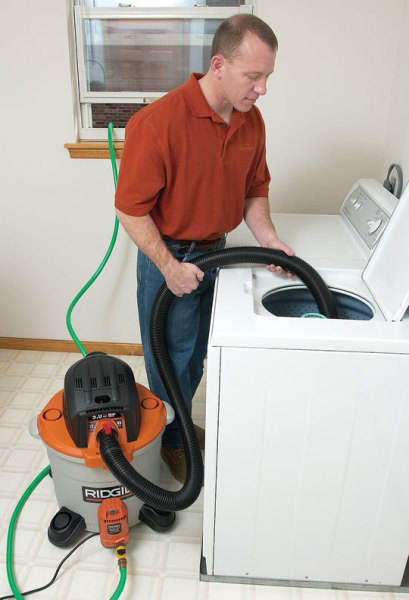
Once filters get clogged, CFM drops dramatically. Cone- or V-shaped filters tend to clog fast and are hard to clean because they trap debris in the narrowest points. The best vacuums are designed so that large debris enters the machine and drops away from the filters to maintain unrestricted airflow.
Power
Unfortunately, there’s a lot of leeway in how manufacturers measure motor performance. Motors may be rated by amperes (amps), horsepower, wattage, or some combination of the three. Amperage is the amount of electric current flowing through the motor, and when multiplied by the line voltage (120 volts in North America), it yields the wattage—a measure of the amount of work (by the standards of physics) that the motor can perform. Wattage has a direct relationship to horsepower. Upon starting, electric motors briefly exhibit surge horsepower, called peak horsepower. This number is often used to promote a vacuum’s power, but it may not equate to overall running performance because the power being touted isn’t necessarily used to generate airflow and suction; less efficient (and cheaper) models may consume the same power as high-quality vacuums but be less effective. That’s why it’s important to factor in CFM and water lift. Ratings of 1,000 watts to 1,350 watts are fairly standard in quality machines.
Another feature to consider is how many amps the vacuum requires as you don’t want to risk blowing a fuse. Because older buildings commonly have 15-amp circuits, it’s best to stay between 8 and 12 amps. Many vacuums now allow attaching power tools, such as sanders, to contain dust before it hits the floor, making amp considerations even more essential.
Long hoses make it easier to vacuum hard-to-reach places. (Photo: Courtesy of Bosch Power Tools)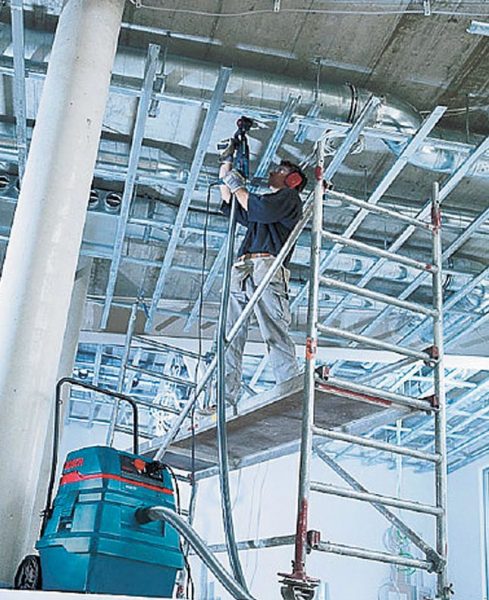
Motor design is another concern. Vacuums create suction using fans and are classed by stages or the number of fans used. Most machines have one or two stages, but three-stage models are becoming more common. Additionally, motors can be either through-flow, using the same air that runs the vacuum to keep the motor cool, or bypass, using only fresh air to cool the motor and separate fans in order to generate airflow and suction. Through-flow motors should have a thermal cutoff control to keep the motor from burning out when a hose is clogged. Because bypass motors have air traveling along several paths, study the CFM ratings, which can drop on lower quality machines. Vacuums that suck water always have bypass motors.
Body Design
A lot of thought goes into designing a good vacuum. Small, lightweight models maneuver better in tight spaces, and unlike older, top-heavy models, vacuums with more balanced bodies are pulled around easily. Handles help a lot, too. When shopping, test the vacuum by pulling the hose to see how the machine handles. The wheels should be well spaced to prevent tipping, as well as large and soft enough to keep them from damaging historic floors.
Noise
There’s a reason why your dog heads under the bed when you turn on a utility vac. Inexpensive vacuums are notorious for emitting noise above acceptable decibel levels, and even 15 minutes of use a day can damage your ears. Look for a vacuum with a decibel rating of 70 or less (though it’s still advisable to wear ear plugs).
Power tools can be connected to many vacuums so that they can collect dust before it hits the floor. (Photo: Courtesy of Fein Power Tools)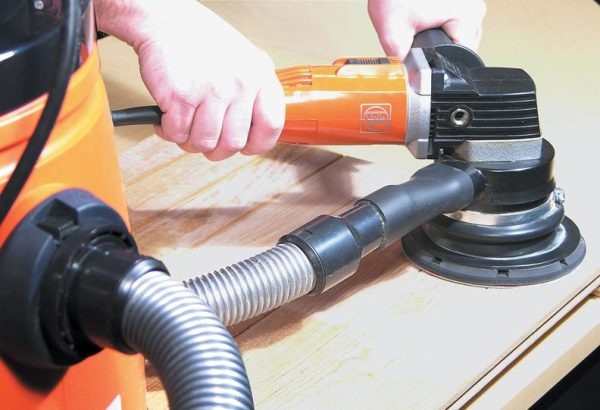
Accessories
The largest hose you can use is determined by the machine’s input hole, but adapters allow you to attach smaller hoses, which reduce hand fatigue at the expense of airflow. A big hose increases the airflow but sacrifices water lift. If you’re picking up lots of large debris, look for a machine that can take a large-diameter hose (standard diameters are 1 1/2″ and 2 1/2″). While a long hose allows you to climb stairs or a ladder and leave the vacuum below, it will cut airflow slightly. Because old houses are famous for having few outlets, a longer cord is a helpful feature, too—ours lets us plug in the vacuum wherever it’s convenient so that we don’t have to mess with extension cords.
The Bottom Line
When it comes to tools and equipment, you get what you pay for. A quality machine usually incorporates a thoughtful design with fewer features to drive you crazy, such as unmanageable cords, latches that won’t stay shut, accessories that fall off, and a body that tips over whenever the wheels hit a good bump. We didn’t skimp on our utility vac, and so far it’s clocked nearly 100,000 hours in 13 years of almost daily use.
Consider your needs carefully, and then pick the most powerful machine you can find (we prefer the highest water lift) that is relatively quiet and has a bypass motor capable of suctioning fine dust particles without burning out. HEPA filtration is highly recommended. Do your homework and scout out local retailers for advice and the peace of mind that comes from knowing a resource is nearby to service your vacuum, should you need it.
Noelle Lord operates Old House C.P.R., a business that specializes in the care of old buildings.







